Andy Zaltzman's Blog, page 11
June 16, 2011
Talking DRS with the ghost of Frank Chester
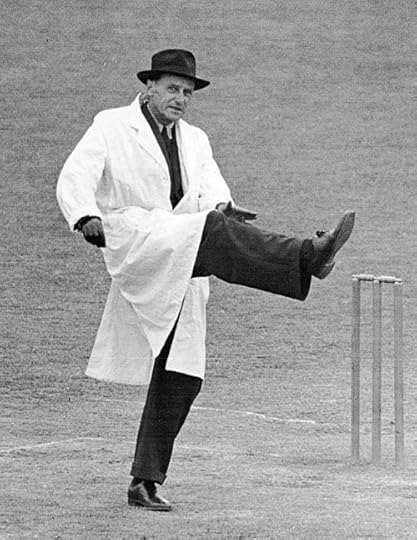
Umpire Chester demonstrates the victory jig he would have performed every time one of his reviewed decisions was upheld
© Getty Images
England and Sri Lanka will do cricketing battle with (a) each other and (b) another unpromising weather forecast in the final Test at Southampton today. It is the Rose Bowl's first Test match. As the old joke goes, new Test grounds in England are like London buses – you wait 100 years for one to turn up, and then three come along in under a decade.
Thus far, excluding the final-afternoon mayhem in Cardiff, when England's bowlers obliterated their opponents like a hungry rhinoceros turning up at a somnolent picnic just as granny was packing away the remnants of a half-eaten pavlova, it has been a middling series. England's imposing batting has only briefly been inconvenienced by Sri Lanka's rather blunt and inexperienced bowlers, and there has been a degree of tactical caution by both sides that has further bunged up the already-rain-stifled cricket.
From England's point-of-view, the series has further illustrated how crucial James Anderson has become to a seam attack that looked both one-paced and one-heighted at Lord's. After averaging under 33 in just two of his previous 11 Test series (early-summer series against New Zealand and West Indies), the Lancastrian is now one good match away from his fourth consecutive series average of 26 or less. From the early days of his international career it was clear that Anderson could, in bowling parlance, "make the ball talk". Unfortunately what he made the ball say was not always "Look out, batsman, I'm an unplayable outswinger"; slightly too often it was, "Ouch, I've been smashed for four again".
As many of his team-mates have done, he has improved markedly with experience and, in an age of dominant batting and often pallid pace bowling, is now one of the most exciting players to watch in world cricket today.
Meanwhile there has been little talk in my house of anything other than India's refusal to use the Decision Review System – easily my favourite decision review system – in the Test series in England later this summer.
Published on June 16, 2011 02:34
June 9, 2011
Why South Africa is in debt to English village cricket
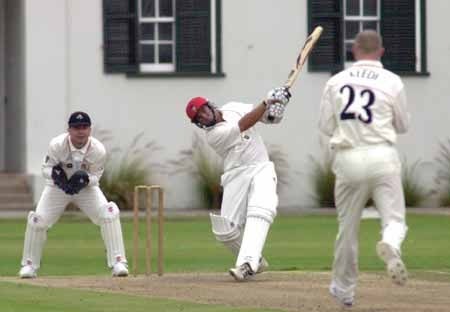
Domingo, yes. Placido, no
© John Dawson
Mohammad Amir's rather naughty appearance in a village match in Surrey has created an understandable stir in the world of cricket. Unsurprisingly, a man who spent much of last summer making Test batsmen look like village players returned tidy figures when bowling to actual village players. Perhaps not tidy enough to have made it worth his while risking his already career-shattering ban being increased still further - even a spell of 10 for 0 would not have tipped those scales - but tidy nonetheless. And the four St Luke's batsmen dismissed can take solace in the fact that Alastair Cook was routinely scalped by Amir last summer, and it seems to have transformed him into an unstoppable animatronic run robot. By this time next summer, expect to see several of the current St Luke's XI firmly ensconced in the England set-up.
I hope Amir's ban is not increased, or that any increase is at least suspended. It would be a shame if any lingering chance of one of the 21st century cricket's greatest talents finding on-the-field redemption is reduced still further by such an idiotic offence.
The selection of "the ringer" has a long and proud history in lower level cricket. And, some would say, in the England team. In fact, the struggles of several Test nations suggests that the ICC should consider allowing the lower-ranked teams to field one ringer of their choice in each match. This would make the international game much more competitive and unpredictable. And make Dale Steyn a very tired man.
Published on June 09, 2011 20:34
June 7, 2011
The truth about the smashed window

"Well done Trottsky, you well-shorn little communist, you"
© Getty Images
Watching the Sri Lankan bowlers struggle in this series – 21 wickets at 61, aided by a late flurry of slog-induced dismissals as England cut loose in an attempt to make sure the game was at least 101% safe before declaring, rather than a risky 100% safe – it is hard to be optimistic about their team's prospects as a Test force in the near future.
Life after Murali is proving to be as difficult as everyone had thought it would be. It was, of course, obvious that Sri Lanka would miss the great tweakster very much, in the same way that a champion racehorse would miss one of its legs, or Sebastian Vettel would miss his steering wheel, or Michelangelo would have missed his paintbrush.
In the seven Tests since Murali bid his spectacular and victorious farewell last July, bowling his team to victory and himself even further into statistical immortality, in Galle against India, Sri Lanka's bowlers have dismissed their opponents for under 430 just once, and have collectively averaged 50. Four of those seven Tests have been against the formidable batting line-ups of India and England, on some fairly unforgiving pitches, but they are inauspicious figures nonetheless.
Cricinfo's undisputed Jimi Hendrix of Stats, S Rajesh, compiled this excellent comparison of Murali and Warne when the former retired last year. The numbers suggest, strongly, that both men were very good at bowling a cricket ball.
Published on June 07, 2011 22:37
May 31, 2011
Tremlett invokes Ambrose and cooks the Bolognese

Kumar Sangakkara finds out that his swivel chair has been stolen and replaced with a stuffed porcupine
© PA
The empty seats of the Swalec Stadium gazed on in astonishment yesterday afternoon as a hitherto grey Test match careered to an explosive ‒ or, depending on your allegiance, implosive ‒ end. England, having shown little real desire to win the game on day 4, blasted their way to a staggering victory with such ultimate comfort that, in the end, not only did they not regret wasting an extra 20 minutes whilst Bell completed one of the less significant hundreds of his increasingly impressive career, but they might now think they could have waited for Morgan to notch up the 86 more runs he needed to post three figures as well. Sri Lanka, who had played with skill and resilience in the first innings, left both of those useful attributes firmly locked in a safe deposit box in their hotel, and subsided like a badly-timed soufflé in the face of the fire of Tremlett and the wiles of Swann.
New captain Dilshan and his men registered the 7th shortest completed Test innings since the Second World War, lasting 148 balls between them on a pitch on which their bowlers had taken English wickets at a rate of one every 186 deliveries. It is fair to say, in modern sporting parlance, that Sri Lanka had 'a bad day at the office'. As office days go, it was roughly equivalent to turning up to work to find that your swivel chair has been stolen and replaced with a stuffed porcupine, before your boss calls you in to give you a 90% pay cut, feed your packed lunch to his pet iguana, and put your trousers through his shredder, after which you return to your desk to find that your colleague has run off with your car keys, half-finished crossword and spouse, and your computer is frozen irretrievably on a YouTube video of Gary Kirsten's unedited double-century at Old Trafford in 1998.
(I should point out that I have not spent much time working in offices. In the brief period of my life in which I did have an office job, every day was 'a bad day at the office'. In fact, even my days not at the office were bad – I took a week's leave to go to that Old Trafford Test, spent two days watching Kirsten, and the remaining three regretting ever discovering cricket.)
Published on May 31, 2011 09:08
May 25, 2011
Deck your souls with psychological bunting

Barack Obama and colleagues look on rapt as Thilan Samaraweera makes his way to a hundred
© Getty Images
The first day of the Test summer. The unquestioned highlight of the British and European year. For English cricket fans, at least. A day when cricket lovers in this country bedeck their souls with psychological bunting and wave metaphorical flags with bats, stumps and balls on at themselves in joyous celebration that humanity's greatest single creation, the crowning glory of all civilisation, the thing described by Abraham Lincoln as "the last best hope of earth" ‒ Test cricket ‒ is back. (Not all scholars agree with my interpretation of Lincoln's words from his address to Congress in 1862, a decade and a half before the birth of Test cricket. But if you try reading that speech out loud with the old BBC cricket theme blaring out of your ghetto blaster, I think and hope that you will reach the same conclusion I did.)
Over the years, the beginning of the summer's Test cricket has lost some of the excitement it had when I was a child in the 1980s, when innumerable questions would swirl around the crickosphere as the first Test loomed. Who would be left in the team from the previous summer? Who would be captaining the side? Who would be captaining the side in a month's time? Who would be the first player dropped, how quickly, and how needlessly? How gruesomely would England lose? And which county stalwart would be speculatively picked in a moment of crisis, then summarily discarded, whilst the selectors consulted tea leaves, ouija boards, the entrails of freshly slaughtered animals and (on rare occasions) the first-class averges?
Few of these questions still arise in the more stable, well-organised 21st century world of England cricket. Most of the media discussion to date seems to involve wild speculation on what may or may not be going on inside Kevin Pietersen's head.
Published on May 25, 2011 21:16
May 18, 2011
Why Darren Sammy is the greatest bowler of all time
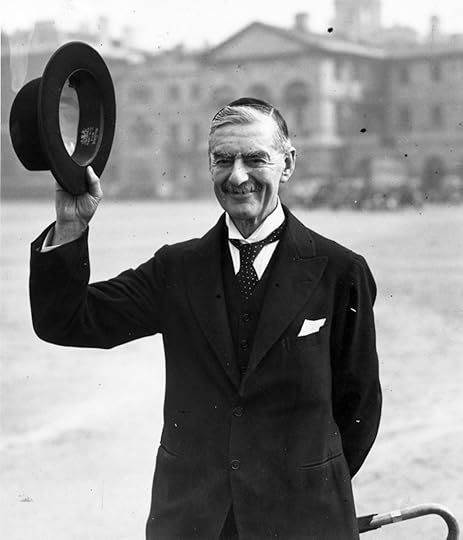
Mr Chamberlain: a believer in moustachioed men being all-round good eggs
© Getty Images
After a prolonged sabbatical spent worrying about its future whilst watching its younger siblings charge around like banshees, Test cricket roared back into life with a low-scoring thriller between West Indies and Pakistan. Admittedly, that roar raised the age-old philosophical question: if something roars in an empty cricket stadium, and no one is there to hear it, does it still make a noise?
It was a gripping match of 19th-century-style scoring, played out in front of a 17th-century-style crowd, in a 21st-century-style stadium – nicely made but pointlessly remote. One day, a high-ranking scientist or Nobel Prize-winning genius will work out on a high-powered computer that if you build soulless modern stadiums, without history or character, far from civilisation, you may on occasion struggle to attract crowds to watch cricket in them. It will take a brain of formidable power to reach this conclusion, a thinker of rare perspicacity, who is prepared not only to think outside the box, but to set fire to the box whilst his head is still inside it to accelerate the thought process.
Low-scoring games have provided some of cricket's all-time classics, from the umbrella-chewing mayhem of The Oval in 1882, when the 19th-century proto-Lillee, Fred Spofforth, demonised the Ashes into existence with brilliant bowling and an intimidating moustache, to England's back-from-the-dead-but-with-hindsight-still-feeling-quite-ill World Cup group win over South Africa in Chennai in March.
Misbah's 52 was the highest score in the Providence Test (which itself sounds like something the cricket community should insist wealthy tycoons pass before being allowed to land at Lord's in a helicopter with a Perspex box full of cash). This is the sixth-lowest highest score, if that makes sense, in a completed Test match since the First World War, and enabled the game to narrowly avoid becoming only the third Test since the Second World War to produce a positive result without featuring any half-centuries.
The previous fifty-free Test was in Hamilton in December 2002, when New Zealand dismissed an Indian batting line-up containing Sehwag, Dravid, Tendulkar, Ganguly and Laxman for 99 and 154, with Daryl Tuffey taking 8 for 53 in the match. It seems scarcely conceivable now, and that sentence might read as if it has been generated by a seriously malfunctioning internet automatic translation programme trying to convert a Swedish recipe for salmon fishcakes into English, but it is in fact 100% true.
Before that, there had only been one other such match since before Neville Chamberlain was waving his piece of paper around, declaring "peace in our time" – a declaration that now looks dodgier than Hansie Cronje's at the Centurion Test in January 2000, and proves that there was a precedent for high-ranking English officials being duped by confident men with moustaches long before the Stanford debacle. The game in question was Edgbaston 1981, when Botham swung England to victory by marmalising Australia's tail, spreading them on toast, and eating them in one mouthful, with 5 for 1 in five overs of legend-solidifying brilliance.
Published on May 18, 2011 00:53
May 10, 2011
What if the IPL had 33 times as many games?

The Black Eyed Peas: John Arlott's most well-known groupies
© Getty Images
Hello Confectionery Stallers, and welcome to my first post-World Cup blog. I have completed a month-long social reassimilation course following my trip of a lifetime around the subcontinent, and am now, on occasion, almost capable of conducting a competent conversation about something other than cricket. I have stopped asking my wife and/or children to hold pretend press conferences in the kitchen explaining their curious batting Powerplay tactics. I no longer wake up in a cold sweat dreaming that I'm bowling to Kevin O'Brien in my own greenhouse. I therefore feel ready to allow cricket back into my life.
A few thoughts on what has happened during my sabbatical:
1. The unstoppable churn of international cricket has continued. Australia and Bangladesh launched the 2011-2015 cycle with an ODI series that began seemingly seconds after MS Dhoni concluded his victory speech in Mumbai. Even by the stretchiest stretch of even the most gymnastic of imaginations, this was too soon.
It is entirely feasible that, when the next World Cup starts, Mitchell Johnson will come charging in with a ball in each hand, and bowl them at two batsmen simultaneously on adjacent pitches, one to Gautam Gambhir in the World Cup opener, and another to Brendon McCullum in the fourth game of a seven-match ODI series that is a crucial early step in the Australians' preparation for World Cup 2019.
2. The IPL juggernaut is plowing on, its golden engine chugging on relentlessly, churning out cricket after cricket after cricket. Fifty-four games played, 20 remaining. I cannot claim to have followed the tournament closely, or even distantly. I am still getting over the disappointment of being ignored at this year's auction. Was I not even worth my $19.99 base price? Even for spare parts?
My family and friends also advised that I take a prolonged break from watching cricket featuring incessant blasts of pop music throughout the game. It has taken me over a month to eradicate the World Cup theme song "De Ghuma Ke" from my brain. I estimate that I heard the song, or snippets thereof, on approximately 8470 separate occasions during the tournament. That is a lie, but the point stands. Merely writing the name of the song has brought the memories flooding back. I may need further treatment. I am still not entirely sure what it means – I assume it was something about slowly building an innings and working the ball into the gaps until your eye is in.
As I wrote at the time, I felt that the ear-assaulting unavoidability of the irrelevant musical interludes on the stadium PA systems neutered genuine atmosphere. However, it should be said in mitigation that, during American hip-hoppers the Black Eyed Peas' recent "The E.N.D. World Tour", at the end of every song they played a 20-second snippet of John Arlott's radio commentary at face-melting volume.
I digress. The IPL team owners and grandees must be casting envious glances at Major League Baseball in America, whose season began at around the same time. The MLB has just ripped through the 450-game barrier, with just under 2000 more matches to go. Plus the up-to-41-game post-season. Each franchise hurls and thwacks its way through 162 games in the regular season, at a rate of six matches per week. Can a window in the international calendar be found for a similar IPL format? If there were 33 times as many games, would it be 33 times as exciting?
3. It was a source of considerable relief that the ICC will reassess its patently bonkers format for the 2015 World Cup. Its proposed 10-team closed-shop retro-style tournament took the concept of cricketing development and clattered it hard in the groin with a 3lb 8oz bat, whilst proudly purring, "Shot, sir. Shot."
On the evidence of this year's World Cup, few could argue that there are 14 teams deserving of a World Cup place. Even fewer, however, could argue that there are only 10, and even fewer than that could claim that the qualification process for selecting those 10 should have been conducted without public notification, and been concluded in 2000 before being kept under wraps until the least opportune moment. It should be 12 teams, and not take too long. Although either one of those two would be nice.
Published on May 10, 2011 22:29
February 16, 2011
Prelude to the World Cup preview
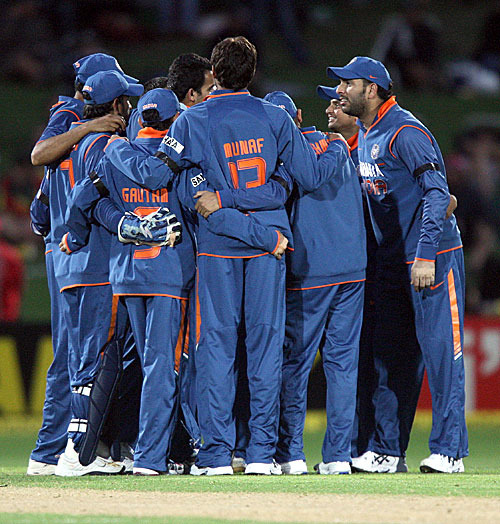
"So it's bounce-bounce-sway, bounce-bounce-sway and then we all fall down"
© Getty Images
Hello Confectionery Stallers, and welcome to my first ever non-UK-written blog. I am currently in Dubai, on my way to Bangladesh, gazing out over the world's most ludicrous skyline (well, gazing at a pair of beige curtains, behind which is a brick wall, from the top of which I might be able to gaze out over the world's most ludicrous skyline).
This is the most open World Cup of the millennium so far, since Herschelle Gibbs unwittingly not only dropped the 1999 World Cup when he shelled Steve Waugh, but the 2003 and 2007 tournaments as well, by boosting Australian confidence so much that they became almost scientifically unbeatable.
The final stages promise to be riveting – seven winner-takes-all shoot-outs, when all the months of preparation could be shattered with one twitch of Billy Bowden's trigger finger, one extra rotation of a captain's lucky coin, or Shahid Afridi putting his head on correctly in the morning. The group stage may be less scintillating. In fact, it will certainly be less scintillating. On the minus side, it is significantly and obviously much too long. On the plus side, I'll get to see more of Bangladesh, India and Sri Lanka than I would have done had the schedule been a little less distended. The early weeks of the tournament may also reveal something of where cricket is heading as a sport: how can the 50-over game and international cricket compete with Twenty20 and the financial behemoth that is the IPL?
I will kicking off my World Cup blog, On the Road with Zaltzman, with the official tournament preview on Friday, including full and irrefutable proof of who will win, and why. And when. In fact, I'll predict the "when" bit right now. I confidently forecast that victory will be secured at some point on April 2, probably in the evening. And I also predict, with equal confidence, that the winning team will stand around in a circle, with their arms around each other's shoulders and bounce up and down. The circular bounce has now become the default sporting victory celebration, other than in individual sports, although I am sure all sports fans would love to see a golfer sink a putt on the 18th green to clinch a triumph, then put his arms around his own shoulders and pogo up and down for a couple of minutes before dousing himself in champagne and trying to lift himself onto his own shoulders.
I will then be posting daily pieces for throughout the tournament – mostly blogs, plus occasional podcasts – and will also be doing a Twitter feed from the games and from my travels around the subcontinent, which you can follow at @ZaltzCricket.
I will also unleash a World Cup MultiStat, plus photos, and possibly even the odd video here and there, if I can work out how to use a video camera and edit rudimentary video footage without making people's eyes hurt. (My inexperience is not necessarily an insurmountable problem. Quentin Tarantino's first forays into film-making were his home movies from the 1956-57 South Africa v England Test series. That is a lie. But it would nonetheless be interesting to see his take on one of the slowest-scoring series of all time, starring Samuel L Jackson as Colin Cowdrey and Uma Thurman as nagging South African offspinner Hugh Tayfield).
And there will be a regular Q&A, for which you will be able to submit questions, which I will (a) attempt to answer, (b) dodge, or (c) wilfully misinterpret. Full details of this will follow on the website.
Published on February 16, 2011 04:19
February 3, 2011
Blaming the Eden Gardens? Look at the Colosseum

The authorities at Heathrow organise an obstacle course for the England team's bonding session before the World Cup
© Getty Images
The World Cup moves ever closer, and the teams are finalising their preparations in readiness for the action. India are grateful that the nation's construction sector is cannily deflecting attention and pressure away from the team. Sri Lanka and West Indies have been focusing their attentions on mastering the mysterious mathematical intricacies of Duckworth-Lewis, and spending large amounts of time sitting around not playing cricket, which, given the tournament schedule, is arguably the best practice they could have wished for.
England will soon return home from Australia for their scheduled 20 minutes of team bonding and conditioning work in a Heathrow airport waiting room before jetting out to Bangladesh, fully refreshed, to launch their campaign. Australia, having honed their one-day skills during the Ashes by refusing to bat for more than one day at a time, and refusing to bowl in more than one innings in a match, are finding form, perhaps buoyed by the knowledge that Steven Smith was a six-year-old boy the last time anyone other than them lifted the World Cup.
Pakistan look like they could beat anyone, including themselves – I believe the draw is such that a Pakistan v Pakistan semi-final is a possibility, if both Pakistan and Pakistan qualify from their groups, and do not beat themselves in their respective quarter-finals. They seem to unearth teenage centurions like archaeologists find bits of broken pottery at an ancient Greek dig, then, similarly, look at them for a bit, discard them, and say, "Plenty more where that came from, I'm sure").
South Africa are locked away in a special research laboratory trying to formulate a new and even crazier way to be knocked out of a tournament, concerned that their form in this regard has dipped in recent years – they have been knocked out of recent tournaments in mostly fairly uninteresting ways, and will be looking to return to their world-leading form of 1999 and 2003.
Bangladesh, who play all their group matches and potentially a quarter-final on home soil, have won seven of their last eight ODIs in their own country, have never lost a World Cup match in Asia (0 losses from 0 games, admittedly), and, after beating New Zealand in four consecutive matches last October, now technically own Brendon McCullum. New Zealand themselves are potential dark horses. For the 10th world cup in succession. Zimbabwe will be looking to build on their promising showing in 1983. And the rest will be preparing to try to enjoy their tournaments as much as possible, in the knowledge that the ICC have reorganised them as far away from the 2015 tournament as possible.
Published on February 03, 2011 04:39
January 27, 2011
Andy Zaltzman's World Cup Memories ‒ Part One of a New One-Part Series
Man versus rhododendron
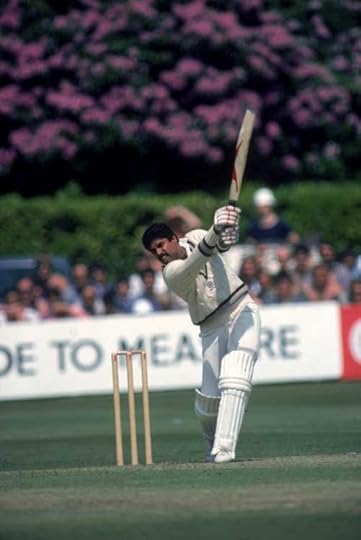
The rhododendrons breathe a sigh of relief as the axeman turns away from them briefly
© Getty Images
Of all the World Cup matches I have attended, my favourite remains the first. Admittedly, my first World Cup match also remains my only World Cup match. But, equally admittedly, even if I had been to every single World Cup match since, it would still be high up the list. Tunbridge Wells, 1983, India v Zimbabwe. Kapil Dev's unmatched masterclass in How To Rescue Your Team From A Perilous 17 for 5.
The first top-level cricket I ever saw was the cream of Indian batsmanship being obliterated. Followed by one of the greatest innings in the history of the game. My cricket-watching career may have peaked too soon. Kapil came to the crease at 9 for 4, eight runs later watched Yashpal Sharma trudge back to the pavilion, looked at the scoreboard, and thought to himself, "1, 7 and 5. That's a nice collection of numbers. I wonder if I can make them appear together on the scoreboard again. Hmm, let me think about that. Yes, I've worked it out, I can. I'll take 1 for 75. No, no, scratch that, I've got an even better idea." A couple of hours later, Kapil left the field to thunderous and ecstatic applause – as thunderous and ecstatic as people are legally allowed to be in Kent, at any rate - with 175 not out to his name, and a place in the World Cup pantheon his for all time.
A small Andy Zaltzman was there to see it, a boy already captured by cricket, entranced by its heroes and numerical intricacies, attending his first game of professional cricket. Few of my school contemporaries at the time were as well-versed in Derek Randall's Test batting average as I was. Fewer still had a reasonable working knowledge of Mansoor Akhtar's performances for Pakistan. When ace 17th-century philosopher Francis Bacon wrote that "knowledge is power", he clearly did not have the same type of knowledge that I possessed as a small boy. Knowledge that proved of little heft in the school playground. (But then again, Bacon himself ultimately died as a result of trying to stuff snow up a dead chicken's posterior, so his "knowledge" was clearly vulnerable to the onset of over-excited but poorly planned experimentation.)
Somehow, and to this day it has never been satisfactorily explained, my father had managed to acquire a pair of tickets to sit in the pavilion, just a few feet from the players' dressing rooms. This was an unmissable autograph-hunting opportunity. The only autographs I had successfully hunted up to that point in my life were that of Geoff Capes, the British strongman and beard enthusiast, who had been a guest at a prize-giving at my school, and the opening batsman from the local village cricket team. I nervously approached this titan of a man, as he slumped into a deckchair with a cigarette after a brief and unsuccessful innings, and politely requested him to sign my notebook. He looked at me with a mixture of surprise, confusion and nervousness, as if he suspected I might be trying to trick him into buying something that he didn't want, as if the last time he had signed an autograph he had returned home to find a few set of automatic remote-controlled curtains and a bill for £3000. Little did I know at the time that village cricketers are unused to fielding autograph requests.

The rhododendrons breathe a sigh of relief as the axeman turns away from them briefly
© Getty Images
Of all the World Cup matches I have attended, my favourite remains the first. Admittedly, my first World Cup match also remains my only World Cup match. But, equally admittedly, even if I had been to every single World Cup match since, it would still be high up the list. Tunbridge Wells, 1983, India v Zimbabwe. Kapil Dev's unmatched masterclass in How To Rescue Your Team From A Perilous 17 for 5.
The first top-level cricket I ever saw was the cream of Indian batsmanship being obliterated. Followed by one of the greatest innings in the history of the game. My cricket-watching career may have peaked too soon. Kapil came to the crease at 9 for 4, eight runs later watched Yashpal Sharma trudge back to the pavilion, looked at the scoreboard, and thought to himself, "1, 7 and 5. That's a nice collection of numbers. I wonder if I can make them appear together on the scoreboard again. Hmm, let me think about that. Yes, I've worked it out, I can. I'll take 1 for 75. No, no, scratch that, I've got an even better idea." A couple of hours later, Kapil left the field to thunderous and ecstatic applause – as thunderous and ecstatic as people are legally allowed to be in Kent, at any rate - with 175 not out to his name, and a place in the World Cup pantheon his for all time.
A small Andy Zaltzman was there to see it, a boy already captured by cricket, entranced by its heroes and numerical intricacies, attending his first game of professional cricket. Few of my school contemporaries at the time were as well-versed in Derek Randall's Test batting average as I was. Fewer still had a reasonable working knowledge of Mansoor Akhtar's performances for Pakistan. When ace 17th-century philosopher Francis Bacon wrote that "knowledge is power", he clearly did not have the same type of knowledge that I possessed as a small boy. Knowledge that proved of little heft in the school playground. (But then again, Bacon himself ultimately died as a result of trying to stuff snow up a dead chicken's posterior, so his "knowledge" was clearly vulnerable to the onset of over-excited but poorly planned experimentation.)
Somehow, and to this day it has never been satisfactorily explained, my father had managed to acquire a pair of tickets to sit in the pavilion, just a few feet from the players' dressing rooms. This was an unmissable autograph-hunting opportunity. The only autographs I had successfully hunted up to that point in my life were that of Geoff Capes, the British strongman and beard enthusiast, who had been a guest at a prize-giving at my school, and the opening batsman from the local village cricket team. I nervously approached this titan of a man, as he slumped into a deckchair with a cigarette after a brief and unsuccessful innings, and politely requested him to sign my notebook. He looked at me with a mixture of surprise, confusion and nervousness, as if he suspected I might be trying to trick him into buying something that he didn't want, as if the last time he had signed an autograph he had returned home to find a few set of automatic remote-controlled curtains and a bill for £3000. Little did I know at the time that village cricketers are unused to fielding autograph requests.
Published on January 27, 2011 21:23
Andy Zaltzman's Blog
- Andy Zaltzman's profile
- 12 followers
Andy Zaltzman isn't a Goodreads Author
(yet),
but they
do have a blog,
so here are some recent posts imported from
their feed.



